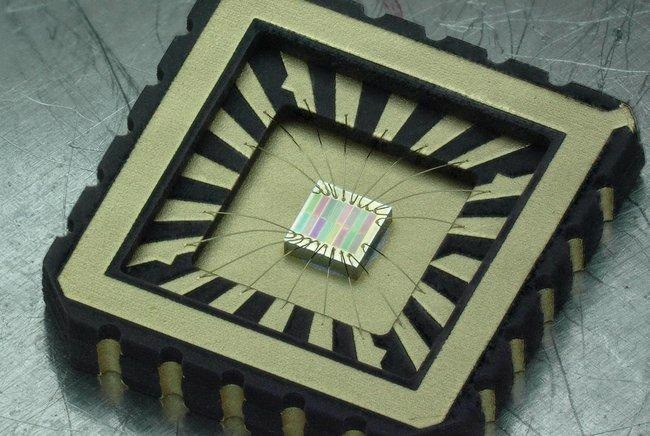A research team from Eindhoven University of Technology (TU/e) has built a new near-infrared sensor that is easy to manufacture, comparable in size to sensors in smartphones and ready for deployment in agriculture and industrial process monitoring.

Image Credit: MantiSpectra.
This innovation has been described in the journal Nature Communications, with co-first author Kaylee Hakkel defending her Ph.D. thesis on January 14th.
The human eye is an amazing sensor. Using three diverse types of photoreceptor cone cells that turn visible light into signals for various colors, the eye provides vital information about the environment around us.
When our brain puts the signals together, it makes a prediction of what the signals mean based on our experiences. For example, a red strawberry is sweet, but a green one is not.
Kaylee Hakkel, Study Co-First Author and PhD Researcher, Photonics and Semiconductor Nanophysics Group, Department of Applied Physics, Eindhoven University of Technology
Size Does Matter
While the human eye is remarkable, it is not comparable with the most cutting-edge natural light sensor out there.
The eyes of the Mantis shrimp have 16 different types of cells, which are sensitive to ultraviolet light, visible, and near-infrared (NIR) light. And measuring the spectrum in the infrared is most interesting for applications in industry and agriculture, but there’s one major issue — current near-infrared spectrometers are just too big and expensive.
Kaylee Hakkel, Study Co-First Author and Ph.D. Researcher, Photonics and Semiconductor Nanophysics Group, Department of Applied Physics, Eindhoven University of Technology
Hakkel and her team have solved this problem by creating a near-infrared sensor that can be placed onto a small chip. Same as the eye of the Mantis shrimp, it comprises 16 different sensors – but they are all perceptive in the near-infrared.
Miniaturization of the sensors while keeping costs low was a major challenge. So, we designed a new wafer-scale fabrication process to achieve this. It’s low-cost because we can produce multiple sensors at the same time, and it’s ready, right now, for use in practical applications in the real world. The sensor chip is small and could even be embedded in future smartphones.
Kaylee Hakkel, Study Co-First Author and Ph.D. Researcher, Photonics and Semiconductor Nanophysics Group, Department of Applied Physics, Eindhoven University of Technology
Solving Spectral Sensing
Andrea Fiore, the study lead from the Department of Applied Physics and the Eindhoven Hendrik Casimir Institute, is pleased with their research team’s efforts. “We’ve been investigating this technology for a number of years. And now we’ve successfully integrated the spectral sensors on a chip, while also dealing with another key issue — efficient use of the data”.
Generally, when a sensor quantifies light, the created signal is used to reconstruct the optical spectrum — or optical fingerprint — for the material. Sensing algorithms are then applied to examine the data.
In this new method, the scientists demonstrate that the step of spectral reconstruction is not required. In other words, the signals produced by the sensors can be transmitted straight to the analysis algorithms. “This significantly simplifies the design requirements for the device,” observes Fiore.
Analyzing Milk and Plastics
With the sensor ready for use, the team then tested the sensor in several experiments, as described by co-first author Maurangelo Petruzzella, who is also employed at the startup company MantiSpectra.
“We used the sensor to measure the nutritional properties of many materials including milk. Our sensor provided comparable accuracy in the prediction of fat content in milk as conventional spectrometers. And then we used the sensor to classify different types of plastic.”
The nutritional properties of milk establish its economic worth, and the sensor has been verified to correctly quantify these properties. Furthermore, these measurements could be used to track the overall health of the cow. Classification of plastic types with the help of the sensor could help enhance the waste sorting processes.
Besides these applications, we anticipate that the sensor could be used for personalized health care, precision agriculture (monitoring the ripeness of fruit and vegetable for instance), process control, and lab-on-chip testing. We now have a full development kit available based on this technology, the SpectraPod™, that companies and research institutes are using to build their applications.
Maurangelo Petruzzella, Study Co-First Author, Department of Applied Physics, Eindhoven University of Technology
“And the great thing is that this sensor could even be commonplace in the smartphones of the future meaning that people could use it at home to check the quality of their food or check aspects of their health,” Petruzzella added.
Mantispectra Future
Things are just beginning to become exciting for Hakkel, who will defend her thesis on January 14th at TU/e. Following this, she will be joining Petruzzella at the startup company MantiSpectra where they will work at advancing the sensor for more real-world applications.
“I’m really excited to start working on the next phase of the sensor development with MantiSpectra. This sensor could contribute to a cleaner environment and address food waste, applications that are important for everyone.”
Journal Reference:
Hakkel, K. D., et al. (2022) Integrated near-infrared spectral sensing. https://www.nature.com/articles/s41467-021-27662-1